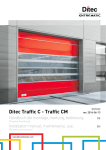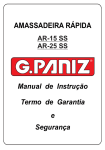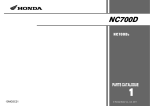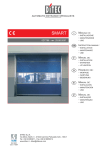Download Ditec Energy
Transcript
Ditec Energy 0DT828 rev. 2014-06-13 Manuale di installazione, manutenzione, uso. (Istruzioni originali) Installation manual, maintenance, use. (Original instructions) www.ditecentrematic.com IT EN Indice degli argomenti Cap.Argomento ............................................................................................................................. Pag. 1. AVVERTENZE GENERALI PER LA SICUREZZA ....................................................................... 2 2. CARATTERISTICHE TECNICHE ................................................................................................ 3 3. INSTALLAZIONE MECCANICA 3.1 Verifiche iniziali........................................................................................................................ 4 3.2 Fissaggio dei montanti verticali................................................................................................ 4 3.3 Montaggio della traversa.......................................................................................................... 4 3.4 Predisposizione della traversa................................................................................................. 4 3.5 Montaggio del telo.................................................................................................................... 4 3.6 Montaggio del motoriduttore.................................................................................................... 4 3.7 Installazione fotocellule............................................................................................................ 4 3.8 Installazione costa di sicurezza............................................................................................... 4 4.COLLEGAMENTI ELETTRICI 4.1 Quadro elettrico....................................................................................................................... 5 4.2 Collegamenti quadro elettrico / automazione........................................................................... 5 4.3 Fotocellule di sicurezza............................................................................................................ 5 5. QUADRO ELETTRONICO 5.1 49E - K22 collegamenti............................................................................................................ 6 5.2 49E - K26 collegamenti.......................................................................................................... 10 5.3 47E (inverter) - collegamenti.................................................................................................. 12 6.REGOLAZIONI ED AVVIAMENTO 6.1 Verifica dei sensi di movimento ............................................................................................. 16 6.2 Regolazione della costa a filo................................................................................................ 16 7. RICERCA GUASTI...................................................................................................................... 17 8. PIANO DI MANUTENZIONE ...................................................................................................... 18 1. AVVERTENZE GENERALI PER LA SICUREZZA Il presente manuale di installazione è rivolto esclusivamente a personale professionalmente competente. L’installazione, i collegamenti elettrici e le regolazioni devono essere effettuati nell’osservanza della Buona Tecnica e in ottemperanza alle norme vigenti. Leggere attentamente le istruzioni prima di iniziare l’installazione del prodotto. Una errata installazione può essere fonte di pericolo. I materiali dell’imballaggio (plastica, polistirolo, ecc.) non vanno dispersi nell’ambiente e non devono essere lasciati alla portata dei bambini in quanto potenziali fonti di pericolo. Prima di iniziare l’installazione verificare l’integrità del prodotto. Non installare il prodotto in ambiente e atmosfera esplosivi: presenza di gas o fumi infiammabili costituiscono un grave pericolo per la sicurezza. Prima di installare la porta, apportare tutte le modifiche strutturali relative alla realizzazione dei franchi di sicurezza ed alla protezione o segregazione di tutte le zone di schiacciamento, cesoiamento, convogliamento e di pericolo in genere. Verificare che la struttura esistente abbia i necessari requisiti di robustezza e stabilità. I dispositivi di sicurezza (fotocellule, coste sensibili, arresto di emergenza, ecc.) devono essere installati tenendo in considerazione: le normative e le direttive in vigore, i criteri della Buona Tecnica, l’ambiente di installazione, la logica di funzionamento del sistema e le forze sviluppate dalla porta o cancello motorizzati. I dispositivi di sicurezza devono proteggere eventuali zone di schiacciamento, cesoiamento, convogliamento e di pericolo in genere, della porta. Applicare le segnalazioni previste dalle norme vigenti per individuare le zone pericolose. Ogni installazione deve avere visibile l’indicazione dei dati identificativi della porta. Prima di collegare l’alimentazione elettrica accertarsi che i dati di targa siano rispondenti a quelli della rete di distribuzione elettrica. Prevedere sulla rete di alimentazione un interruttore/sezionatore onnipolare con distanza d’apertura dei contatti uguale o superiore a 3 mm. Verificare che a monte dell’impianto elettrico vi sia un interruttore differenziale e una protezione di sovracorrente adeguati. Collegare la porta ad un efficace impianto di messa a terra eseguito come previsto dalle vigenti norme di sicurezza. Il costruttore della porta declina ogni responsabilità qualora vengano installati componenti incompatibili ai fini della sicurezza e del buon funzionamento o qualora vengano effettuate modifiche di qualsiasi natura senza la specifica autorizzazione del costruttore stesso. Per l’eventuale riparazione o sostituzione dei prodotti dovranno essere utilizzati esclusivamente ricambi originali Entrematic Group AB. L’installatore deve fornire tutte le informazioni relative al funzionamento automatico, manuale e di emergenza della porta o cancello motorizzati, e consegnare all’utilizzatore dell’impianto le istruzioni d’uso. Accessorio opzionale C Safety Confort T Safety Top Tutti i diritti sono riservati I dati riportati sono stati redatti e controllati con la massima cura. Tuttavia non possiamo assumerci alcuna responsabilità per eventuali errori, omissioni o approssimazioni dovute ad esigenze tecniche o grafiche. 0DT828 2014-06-13 -2- IT 9 4 3 1 10 11 2 17 12 7 16 15 13 18 14 5 21 20 19 8 6 Rif. 1 2 3 4 5 6 7 8 9 10 11 Descrizione Cassonetto Motoriduttore K22 / K26 Albero di avvolgimento Tamburo cinghia contrappeso Profilo in alluminio costa di sicurezza Profilo in gomma costa di sicurezza Scatola collegamento costa Cavo collegamento costa Dispositivo di manovra manuale Asta per manovra manuale Colonna destra Rif. 12 13 14 15 16 17 18 19 20 21 Descrizione Colonna sinistra Profili alluminio telo Tubo rinforzo telo Quadro elettronico Fotocellula LAB4 Cinghia sollevamento telo Attacco cinghia telo Settore trasparente Settore in poliestere Tasca rivestimento costa 2. CARATTERISTICHE TECNICHE QUADRO ELETTRICO TRIFASE (49E) QUADRO ELETTRICO INVERTER (47E) Tensione alimentazione ...................... 400 V, 50/60 Hz Assorbimento di linea .............................................. 6 A Alimentazione comandi ausiliari.......................24V Potenza motore.............................................. 0,75 KW Grado di protezione quadro di comando............. IP 55 Temperatura di esercizio............................ - 5 + 50 °C Tensione alimentazione ...... 230 V monofase 50/60 Hz Assorbimento di linea ............................................ 16 A Alimentazione comandi ausiliari.......................24V Potenza motore.............................................. 0,75 KW Grado di protezione quadro di comando............. IP 55 Temperatura di esercizio............................ - 5 + 50 °C Dimensionare correttamente la sezione dei conduttori di linea riferendosi all’assorbimento indicato e considerando lunghezza e posa in opera dei cavi. -3- 0DT828 2014-06-13 3. INSTALLAZIONE MECCANICA Vedi disegni relativi all’installazione meccanica a pagina 24 - 25 (foglio centrale da staccare) 3.1 Verifiche iniziali (fig.1) • Verificare le dimensioni del vano e la rispondenza con le misure della porta. Verificare eventuali ingombri esistenti non ostacolino il montaggio. • Assicurarsi che i piani d’appoggio siano livellati ed eventualmente ripristinarli mediante spessori adeguati. • Verificare la consistenza della struttura del vano: deve essere garantito un sicuro ancoraggio mediante staffe o tasselli. In caso di scarsa o dubbia consistenza è necessario realizzare un’adeguata struttura metallica autoportante. 3.2 Fissaggio dei montanti verticali (fig.2) • Misurare l’ingombro totale della traversa (LT) e contrassegnare la posizione dei montanti verticali. • Fissare le basi dei montanti sui contrassegni, con tasselli dimensione M8 (fig 4). • Mettere a piombo i montanti verticali e fissarli (A) per staffe esterne o (B) per fissaggio da interno colonna. Dimensione tasselli M8. Verificare le diagonali. 3.3 Montaggio della traversa • Rimuovere i bulloni M8 che sono premontati alle estremità della traversa. • Sollevare la traversa con adeguato mezzo di sollevamento. • Appoggiare la traversa sui montanti verticali, reinserire i bulloni di fissaggio e serrarli (fig.3). • In caso di porte con PL > 4000 si consiglia di fissare centralmente la traversa (per evitare una flessione antiestetica della carpenteria). 3.4 Predisposizione della traversa • Riferendosi alle (fig.5A-5B), posizionare la ruota di rinvio cinghia in funzione della posizione del telo, la predisposizione standard è quella di (fig.5A). • Nel caso la ruota di rinvio cinghia non dovesse essere mantenuta nella posizione tipo “5A”, rimuovere la stessa svitando il bullone M8, e rimettere la ruota di rinvio cinghia nella posizione desiderata. Dopo aver fissato la ruota verificare che ruoti liberamente. Ripetere l’operazione per ogni supporto 3.5 Montaggio del telo • Inserire il telo nei montanti verticali e sollevarlo, verificando la giusta posizione degli anelli passa cinghia • Fissare mediante i bulloni M8 in dotazione il manicotto attacco telo alla traversa (fig.6). • Far scendere il telo sino al completo svolgimento. Regolare la lunghezza del telo avvolgendolo, se necessario, sul tubolare di aggancio. • Srotolare le cinghie di sollevamento telo lasciando sul tamburo di avvolgimento almeno due giri di ricchezza (fig.5). • Inserire le cinghie negli anelli passa-cinghia già predisposti lungo il telo (fig.7). • Fissare le parti terminali delle cinghie mediante le staffe poste sul 1° tubo (fig.7). • Fissare i tubi mediante i gusci in plastica per evitare il loro scivolamento laterale (fig.8) sul 1° tubo i gusci sono già fissati. 3.6 Montaggio del Motoriduttore manovra manuale, se previsto, inserire il dispositivo seguendo le indicazioni di (fig.9) per K22 e di (fig.10) nel caso di K26. Collegare il microcontatto di sicurezza seguendo il relativo schema e verificare il corretto funzionamento: il microcontatto deve inibire la rotazione del motore all'innesto della manovra manuale. • Inserire la chiavetta (d) nell'apposita sede (e) sull'albero di avvolgimento (fig.12). • Infilare il motoriduttore sull'albero. • Fissare il motoriduttore sulla testata (fig.12) mediante l'apposito fissaggio. • Inserire il gruppo silent block nell’apposita sede (f) della piastra di supporto posizionando i componenti come rappresentato nella (fig.13). (g) rosetta 13x24 - (h) silent block Ø 25 - (i) rosetta 14x36 - (m) vite 12x55 • Fissare il silent block col dado (l). 3.7 Installazione fotocellule • installare i contenitori sulla colonna. Per installazione e collegamenti utilizzare le istruzioni inserite nel confezionamento fotocellule (fig.14). 3.8 Installazione costa di sicurezza • Posizionare il telo a circa 1m di altezza. • Inserire la costa di sicurezza nella tasca inferiore del telo, (fig.15). • Far scorrere la costa per tutta la lunghezza del telo e centrarla perfettamente rispetto al telo stesso. 0DT828 2014-06-13 -4- IT 4. COLLEGAMENTI ELETTRICI 4.1 Quadro elettrico • Inserire nel contenitore i cavi con le morsettiere precablate e connetterli alle schede (fig.16). Alloggiare i cavi nella canalina e collegare i connettori predisposti sul motore (fig.17). 4.2 Collegamenti quadro elettrico / motore / sicurezze • In figura 18 sono mostrati schematicamente i cablaggi forniti e il loro posizionamento nella porta; ogni cablaggio è identificato da un codice apposto su una etichetta adesiva. 4.3 Fotocellule di sicurezza • Eseguire i collegamenti come indicato in (fig.18). • Eseguire i collegamenti nel quadro elettronico come indicato negli schemi 16 17 18 FC C T 0 1 Tx1 Nero Blu Tx2 Nero Blu Nero Blu Arancio Rosso A934E/L A451L Rx2 7982 7982 0 1 0 1 0 1 Rx1 Nero Blu Arancio Rosso 4327 7978 A935G/E A935L 4328 7979 7825A M Dimensionare correttamente la sezione dei conduttori di linea riferendosi all’assorbimento indicato e considerando lunghezza e posa in opera dei cavi. -5- 0DT828 2014-06-13 49E 5.1 QUADRO ELETTRONICO 49E - Collegamenti INGRESSI Comando Funzione Descrizione 1 2 N.O Chiusura automatica La chiusura permanente del contatto abilita la chiusura automatica. 1 3 N.O Apertura Passo passo Con DIP1=ON la chiusura del contatto attiva la manovra di apertura. Con DIP1=OFF la chiusura del contatto attiva una manovra di apertura o chiusura in sequenza: apre-stop-chiude-apre. N.B.: se la chiusura automatica è abilitata, lo stop non è permanente ma della durata impostata da TC. 1 4 N.O Chiusura La chiusura del contatto attiva la manovra di chiusura. 1 6 N.C Sicurezza di inversione L’apertura del contatto di sicurezza provoca l’inversione del movimento (riapertura) durante la fase di chiusura. 41 8 N.C Sicurezza di inversione L’apertura del contatto di sicurezza provoca l’inversione del movimento (riapertura) durante la fase di chiusura. 1 9 N.C Stop L’apertura del contatto di sicurezza provoca l’arresto del movimento. 1 9 N.O Comando non impulsivo L’apertura permanente del contatto di sicurezza abilita il funzionamento comando non impulsivo. In questa condizione, i comandi di apertura (1-3/1-20) e di chiusura (1-4) funzionano solo se mantenuti premuti, al loro rilascio l’automazione si ferma. Le eventuali sicurezze presenti, il comando passo-passo e la chiusura automatica sono disabilitati. 1 20 N.O Apertura parziale La chiusura del contatto attiva una manovra di apertura parziale della durata impostata mediante il trimmer RP. Ad automazione ferma il comando di apertura parziale effettua la manovra opposta a quella precedente all’arresto. 0 11 N.C Finecorsa chiude L’apertura del contatto del finecorsa arresta il movimento di chiusura. 0 12 N.C Finecorsa apre L’apertura del contatto del finecorsa arresta il movimento di apertura. 0 17 N.O Finecorsa fotocellula By-pass fotocellule Funzionamento a comando non impulsivo Funzionamento a comando impulsivo 17 14 12 11 0 0 0 1 1 2 3 4 6 8 9 20 41 17 14 12 11 0 0 0 1 1 2 3 4 6 8 9 20 41 USCITE Uscita Valore Descrizione 1 0 + – 24 V= / 0,5 A Alimentazione accessori. Uscita per alimentazione accessori esterni comprese lampade stato automazione. 0 14 24 V = / 50 W (2 A) Lampeggiante (LAMPH). Si attiva durante le manovre di apertura e chiusura. UWV M 3~ 0DT828 2014-06-13 400 V~ / 4 A Motore trifase. N.B.: se la rotazione del motore non corrisponde al corretto senso di marcia invertire le fasi U - W -6- IT Finecorsa apre Nero Freno J7 U V M 3~ 1 3 9 4 LDV LDR 20 W SE T RP TC ON Bianco ON Rosso 1 2 3 4 5 6 - LK + 11 12 17 IN Collegamento da completare dall'installatore EO SO Grigio Rosso Stop Marrone X Z Y U W V COM Giallo/Verde 00000000000 F4 Finecorsa chiude 140 Non collegare EL07PW1 IN1 41 1 Blu C www.ditec.it OUT1 Nero 00000000000 PRG Marrone EL07L A 12 11 0 Bianco By-pass fotocellule Bianco B 17 0 FU K22 SA POWER NIO 4328 L3 Marrone Bianco Nero Blu Arancio L2 Nero Blu Arancio Rosso L1 Bianco Marrone 7825A 7979 Nero Blu Rosso 4327 17 14 12 11 0 0 0 1 1 2 3 4 6 8 9 20 41 1-9 Chiudere: Funzionamento a comando impulsivo A935L A935G / E 0 1 Rosso Arancio Blu Nero Marrone Blu A451L 01 Blu Nero 0 1 Nero Blu SOF Arancio SOF Rosso T A934E/L TX2 RX2 0 1 01 RX1 TX1 0 1 7982 1 6 1 0 7982 T Rosso Arancio Blu Nero T Nero Blu 1 0 7978 Collegamento standard precablato 17 14 12 11 0 0 0 1 1 2 3 4 6 8 9 20 41 Marrone Bianco Arancio Rosso Blu Nero Nero Blu Arancio Rosso 1-9 Chiudere: Funzionamento a comando impulsivo 7825A A935C A935G / E 0 1 Rosso Arancio Blu Marrone Blu Nero C A451L 0 1 8 41 TX2 01 Blu Nero Nero Blu Arancio Rosso C A934E/L RX2 01 C TX1 RX1 0 1 -7- 7982 1 6 1 0 7982 C Rosso Arancio Blu Nero 0 Nero 1 Blu 1 0 0DT828 2014-06-13 REGOLAZIONI E SEGNALAZIONI 49E Trimmer TC RP Descrizione 0s 30 s 0s 30 s Regolazione tempo chiusura automatica. Da 0 a 30 s. N.B.: dopo l’attivazione del comando di stop, alla richiusura del contatto 1-9, la chiusura automatica si abilita solo dopo un comando di apertura totale, parziale o passo-passo. Regolazione apertura parziale Da 0 a 30 s. Dip - switch Per Ditec Energy posizionare i Dip-switch così: ON 1 2 3 4 5 6 Ponticelli Descrizione OFF ON DIP 1 Funzionamento comando 1-3. Passo-Passo Apertura DIP 2 Rinnovo tempo chiusura automatica. Non Usare 100 % DIP 3 Prelampeggio fisso di 3 s. Disabilitato in apertura Abilitato in apertura e in chiusura DIP 4 Tipologia applicazione. Non Usare Porta rapida DIP 5 Freno dinamico in chiusura Disabilitato Non Usare DIP 6 Doppia velocità Disabilitato Non Usare Descrizione OFF ON SO Funzionamento sicurezza di inversione A porta chiusa, se il contatto 41- A porta chiusa, se il contatto 41-8 8 è aperto, è possibile attivare la è aperto, viene impedita qualsiasi manovra di apertura. manovra. EO Elettrofreno. Non Usare. LED POWER Acceso Normale. Lampeggiante / Presenza di alimentazione 24 V=. - Indica la funzione di STOP attivata da pulsantiera PT4 (se presente). - Nel caso di utilizzo di dispositivo AUTOTEST, indica il fallimento del test di sicurezza (morsetto 41). - All’accensione il LED lampeggia indicando il conteggio delle manovre effettuate: ogni lampeggio veloce = 10000 manovre ogni lampeggio lento = 100000 manovre SA Indica che almeno uno dei contatti di sicurezza è aperto. ( 6 - 8 - 9 ) IN Si accende ad ogni comando e ad ogni variazione di dip-switch e ponticelli. / 11 Indica che il contatto del finecorsa di chiusura è impegnato 0-11 é aperto. / 12 Indica che il contatto del finecorsa di apertura è impegnato 0-12 é aperto. / 17 Indica che il contatto del finecorsa 0-17 é aperto. (non utilizzato) / Pulsante LED on Attiva la manovra di apertura. Il led verde acceso segnala la presenza di alimentazione 24 V=. Attiva la manovra di apertura parziale. Attiva e disattiva la funzione di STOP. Il led rosso acceso segnala l’attivazione dello STOP. Il led rosso lampeggiante segnala l’attivazione delle sicurezze. Attiva la manovra di chiusura. 0DT828 2014-06-13 -8- IT 49E EL07L SE 00000000000 www.ditec.it EL07PW1 00000000000 FU F4 ON COM U W V PRG 1 3 9 4 LDV LDR 20 EO SO RP TC ON ON 1 2 3 4 5 6 - LK + 11 12 17 IN SA POWER NIO 17 14 12 11 0 0 0 1 1 2 3 4 6 8 9 20 41 L3 L2 F1 L1 F2 F3 FUSIBILI ID Valori Dimensione Circuito F1 - F2 - F3 8A - 500V 10.3 x 38 Linea Trifase F4 3.15A - 230V 5 x 20 Trasformatore Regolazione finecorsa 1. Azionare la porta, premendo i relativi pulsanti, e verificare il corretto senso di movimento e se necessario, invertire il senso del movimento modificando la sequenza delle fasi, agendo sui fili di linea a monte dell’interruttore generale. C A 2. Portare il telo in posizione di chiusura. 3. Mediante cacciavite ruotare la camma “C” sino ad impegnare il relativo microswitch. A 4. Agire analogamente per il finecorsa di apertura: portare il telo nella posizione di porta aperta e regolare la camma “A”. 5. Verificare la taratura con funzionamento effettivo dell’automazione, se necessario effettuare una taratura “fine”. C -9- 0DT828 2014-06-13 5.2 QUADRO ELETTRONICO 49E - Collegamenti 49E Trimmer TC RP Descrizione 0s 30 s 0s 30 s Per Ditec Energy posizionare i Dip-switch così: Regolazione tempo chiusura automatica. Da 0 a 30 s. N.B.: dopo l’attivazione del comando di stop, alla richiusura del contatto 1-9, la chiusura automatica si abilita solo dopo un comando di apertura totale, parziale o passo-passo. Regolazione apertura parziale Da 0 a 30 s. Dip - switch ON 1 2 3 4 5 6 Descrizione OFF ON DIP 1 Funzionamento comando 1-3. Passo-Passo Apertura DIP 2 Rinnovo tempo chiusura automatica. Non Usare 100 % DIP 3 Prelampeggio fisso di 3 s. Disabilitato in apertura Abilitato in apertura e in chiusura DIP 4 Tipologia applicazione. Non Usare Porta rapida DIP 5 Freno dinamico in chiusura Disabilitato Non Usare DIP 6 Doppia velocità Disabilitato Non Usare • PER TABELLA DESCRIZIONE INGRESSI FARE RIFERIMENTO ALLA TABELLA DI PAG. 6 • PER TABELLA DESCRIZIONE LED DI SEGNALAZIONE VEDERE PAG. 8 USCITE Uscita Valore Descrizione 1 0 + – 24 V = / 0,5 A Alimentazione accessori. Uscita per alimentazione accessori esterni comprese lampade stato automazione. 0 14 24 V = / 50 W (2 A) Lampeggiante (LAMPH). Si attiva durante le manovre di apertura e chiusura. 24 V = / 0,5 A Uscita attiva durante il movimento della porta. 400 V~ / 4 A Motore trifase. N.B.: se la rotazione del motore non corrisponde al corretto senso di marcia invertire le fasi U - W -LK+ UWV M 3~ Regolazione finecorsa 1. Azionare la porta, premendo i relativi pulsanti, e verificare il corretto senso di movimento e se necessario, invertire il senso del movimento modificando la sequenza delle fasi, agendo sui fili di linea a monte dell’interruttore generale. A C 2. Portare il telo in posizione di chiusura. A 3. Mediante cacciavite ruotare la camma “C” sino ad impegnare il relativo microswitch. 4. Agire analogamente per il finecorsa di apertura: portare il telo nella posizione di porta aperta e regolare la camma “A”. 5. Verificare la taratura con funzionamento effettivo dell’automazione, se necessario effettuare una taratura “fine”. C 0DT828 2014-06-13 - 10 - B 17 A EL07L Finecorsa apre 00000000000 Finecorsa chiude www.ditec.it Giallo/Verde U V Freno Bianco Rosso M 3~ 1 3 9 4 LDV LDR 20 T ON 1 2 3 4 5 6 - LK + K26 11 OUT1 ON Bianco Rosso 12 17 IN Collegamento da completare dall'installatore EO SO RP TC W Grigio PRG 140 J7 8043 COM Nero 00000000000 F4 Stop Marrone EL07PW1 U W V Blu C IN1 41 1 Nero SE 12 11 0 Bianco FU Marrone IT SA POWER NIO 4328 7979 Marrone Bianco Nero Blu Arancio Bianco Marrone Nero Blu Arancio Rosso A935L L2 L1 1-9 Chiudere: Funzionamento a comando impulsivo 7825A 7978 L3 Nero Blu Rosso 8021 17 14 12 11 0 0 0 1 1 2 3 4 6 8 9 20 41 A935G / E 0 1 Rosso Arancio Blu Nero Marrone Blu A451L 0 1 Collegamento standard precablato Blu Nero 01 RX1 TX1 Nero Blu 0 1 1 0 7982 1 6 1 0 7982 T Rosso Arancio Blu Nero T 1-9 Chiudere: Funzionamento a comando impulsivo 17 14 12 11 0 0 0 1 1 2 3 4 6 8 9 20 41 Marrone Bianco Arancio Rosso Blu Nero Nero Blu Arancio Rosso 7825A A935C A935G / E 0 1 Rosso Arancio Blu Marrone Blu Nero C 0 1 01 Nero Blu SOF Arancio SOF Rosso T A934E/L TX2 RX2 A451L 0 1 8 41 TX2 01 Blu Nero Nero Blu Arancio Rosso C A934E/L RX2 01 C TX1 0 Nero 1 Blu - 11 - RX1 0 1 1 0 7982 1 6 1 0 7982 C Rosso Arancio Blu Nero 0DT828 2014-06-13 5.3 QUADRO ELETTRONICO 47E (INVERTER) - Collegamenti 47E Tagliare sempre il ponte J2 su porta Ditec Energy INGRESSI Comando Funzione Descrizione 1 2 N.O Chiusura automatica La chiusura permanente del contatto abilita la chiusura automatica. 1 3 N.O Apertura La chiusura del contatto attiva la manovra di apertura. 1 4 N.O Chiusura La chiusura del contatto attiva la manovra di chiusura. 41 40 N.C Sicurezza di inversione L’apertura del contatto di sicurezza provoca l’inversione del movimento (riapertura) durante la fase di chiusura. 1 8 N.C Sicurezza di inversione L’apertura del contatto di sicurezza provoca l’inversione del movimento (riapertura) durante la fase di chiusura. 1 9 N.C Stop L’apertura del contatto di sicurezza provoca l’arresto del movimento. 1 9 N.O Comando non impulsivo L’apertura permanente del contatto di sicurezza abilita il funzionamento comando non impulsivo. In questa condizione, i comandi di apertura (1-3/1-20) e di chiusura (1-4) funzionano solo se mantenuti premuti, al loro rilascio l’automazione si ferma. Le eventuali sicurezze presenti, il comando passo-passo e la chiusura automatica sono disabilitati. 1 20 N.O Apertura parziale La chiusura del contatto attiva una manovra di apertura parziale della durata impostata mediante il trimmer RP. 1 11 N.C Finecorsa chiude L’apertura del contatto del finecorsa arresta il movimento di chiusura. 1 12 N.C Finecorsa rallentamento L’apertura del contatto del finecorsa attiva il rallentamento in apertura. 1 13 N.C Finecorsa apre L’apertura del contatto del finecorsa arresta il movimento di apertura. USCITE Uscita + - 1 0 LAMP Valore Descrizione 24 V = / 0,5 A Alimentazione accessori. Uscita per alimentazione accessori esterni comprese lampade stato automazione. 230 V~ / 50 W Lampeggiante (LAMP). Si attiva durante le manovre di apertura e chiusura. RF 100Ω 32w Abilitazione resistenza di frenatura RF La resistenza è abilitata durante ogni manovra CNT -F +F 200 V = / 0,2 A Elettrofreno motore. L'uscita è attiva per tutta la durata del movimento sia in apertura che in chiusura. UWV M 3~ 0DT828 2014-06-13 230 V~ / 6 A Motore trifase. - 12 - IT K22INVY Marrone 12 Bianco 13 11 0 Nero Blu B Finecorsa rallentamento CNT A C 17 Finecorsa apre 1 140 Giallo/Verde U V Nero 16 Finecorsa chiude Stop Marrone +F -F U V W Freno M 3~ GND P 2.0 OUT1 T6 U24 W Grigio IN1 Bianco 11 J1 10 9 8 7 6 5 N F1 F2 T4 T3 1 2 3 4 T2 14 1 11 12 13 SOFA1 4 T1 3 2 1 DL 41 40 20 9 8 4 3 2 1 1 0 LAMP Blu Nero Marrone Bianco 230 V 50/60 Hz Arancio Rosso Blu Nero Marrone Bianco Collegamento da completare dall'installatore T OFF 15 POWER 4328 4327 1 41 I N 1 J2 7979 12 ON Rosso L T5 13 7825A Nero Blu Arancio Rosso 1-9 Chiudere: Funzionamento a comando impulsivo A935L A935G / E 0 1 Rosso Arancio Blu Nero Marrone Blu A451L 01 Blu Nero 0 1 Nero Blu SOF Arancio SOF Rosso T A934E/L TX2 RX2 0 1 01 RX1 TX1 Nero Blu 0 1 T 1 0 7982 1 6 1 0 7982 T Rosso Arancio Blu Nero 7978 Collegamento standard precablato 1 11 12 13 41 40 20 9 8 4 3 2 1 1 0 LAMP 1-9 Chiudere: Funzionamento a comando impulsivo Nero Blu Rosso Arancio Bianco Marrone Nero Blu Arancio Rosso 7825A A935L A935G / E 0 1 Rosso Arancio Blu Marrone Blu Nero C A451L 0 1 8 41 01 Blu Nero Nero Blu Arancio Rosso C A934E/L TX2 RX2 01 TX1 0 Nero 1 Blu - 13 - C RX1 0 1 1 0 7982 1 6 1 0 7982 C Rosso Arancio Blu Nero 0DT828 2014-06-13 REGOLAZIONI E SEGNALAZIONI 47E Trimmer Descrizione T1 0s 30 s Regolazione tempo chiusura automatica. Da 0 a 30 s. T2 0s 10 s Regolazione apertura parziale. Da 0 a 10 s. 0 MAX 0 MAX 0 MAX 0 MAX T3 T4 T5 T6 Dip - switch Regolazione velocità apertura. Regolazione velocità chiusura. Regolazione decelerazione in apertura. Regolazione decelerazione in chiusura. Determina anche il punto di effettiva chiusura Descrizione OFF ON DIP 1 Abilita regolazione tramite trimmer Disabilitato. Abilitato. DIP 2 Prelampeggio apertura Disabilitato. Abilitato. DIP 3 Uso Futuro Non Usare Non Usare DIP 4 Uso Futuro Non Usare Non Usare Alimentazione freno Freno 200 Vcc J2 LED Input DL1 (2) DL2 LED Input Chiusura automatica DL10 (12) F.C rallentamento (3) Apertura DL11 (11) F.C Chiusura DL3 (4) Chiusura DL12 Lampeggiante DL4 (9) Stop DL13 RUN OK DL5 (20) Apertura Parziale DL14 Fault DL6 (40) Sicurezza costa DL15 Autotest Pulsante stop DL16 Freno DL17 Conta monovre DL7 Acceso DL8 (8) Sicurezza in chiusura DL9 (13) F.C Apertura Pulsante Acceso LED on Attiva la manovra di apertura. Il led verde acceso segnala la presenza di alimentazione 24 V=. Attiva la manovra di apertura parziale. Attiva e disattiva la funzione di STOP. Il led rosso acceso segnala l’attivazione dello STOP. Il led rosso lampeggiante segnala l’attivazione delle sicurezze. Attiva la manovra di chiusura. 0DT828 2014-06-13 - 14 - 47E IT Tagliare sempre il ponte J2 su porta Ditec Energy CNT 17 +F -F U V W 16 ON 1 GND U24 13 J2 OFF J1 10 F2 T4 14 T3 T2 T1 11 F1 T5 1 2 3 4 15 N T6 12 ON L 9 1 11 12 13 8 7 6 5 4 3 2 1 DL 41 40 20 9 8 4 3 2 1 1 0 LAMP 230 V 50/60 Hz FUSIBILI ID Valori Dimensione Circuito F1 - F2 12A - 500V 10.3 x 38 Linea Monofase Regolazione finecorsa C 1. Tarare le rampe di decelerazione a zero. (T5 - T6) B A 2. Tarare il finecorsa (C) sul motoriduttore, in modo che la porta si fermi a circa 200/300 mm dal punto di chiusura. 3. Tarare il finecorsa di apertura (A), al punto di apertura. A 4. Tarare il finecorsa di rallentamento (B) in modo che si impegni a circa ¾ della corsa di apertura. B 5. Tarare le velocità di apertura mediante trimmer (T3) e chiusura (T4). 6. Tarare i trimmer delle rampe di decelerazione (T5) apertura e (T6) chiusura, in modo da ottenere la fermata nelle posizioni effettive di porta aperta e chiusa. ¾ C 300 RICERCA GUASTI COMANDO PROBLEMA VERIFICA Un comando qualsiasi, Il telo e il motore non si • Test del quadro elettronico fallito (led 13 verde spento e led in qualsiasi posizione muovono 14 rosso acceso) del telo Comando di apertura Il motore si muove a • Verificare se il ponte J2 è stato tagliato (freno non si attiva) fatica o non raggiunge la • Verificare che la tensione di rete resti costante durante la velocità regolata manovra • Abbassare il trimmer della velocità in apertura (T3) Durante la manovra di Il motore non effettua la • Regolazione del finecorsa di chiusura (C) a circa 300mm dal chiusura rampa di decelerazione pavimento • Regolazione della rampa di decelerazione mediante trimmer T6 NB per la diagnostica generale vedere anche a pag. 17 - 15 - 0DT828 2014-06-13 6. VERIFICHE ED AVVIAMENTO 6.1 Verifica dei sensi di movimento • Portare il telo a circa metà della corsa. • Azionare la porta, premendo i relativi pulsanti, e verificare il corretto senso di movimento. • Se necessario, invertire il senso del movimento modificando la sequenza delle fasi, agendo sui fili di linea a monte dell'interruttore generale. 6.2 Regolazione della costa a filo • Avvitare fino intervento microswitch, successivamente allentare 1/2 giro. Bloccare il contatto (fig.19). 19 0DT828 2014-06-13 - 16 - IT 7. RICERCA GUASTI Prima di svolgere ogni operazione e lavoro all’interno delle apparecchiature elettroniche assicurarsi PERICOLO che la linea elettrica di alimentazione sia stata rimossa Le seguenti istruzioni sono indirizzate esclusivamente a personale qualificato e autorizzato. Leggi e ATTENZIONE normative specifiche devono sempre essere seguite anche dove non espressamente indicato. Per riparazioni o sostituzioni utilizzare sempre e solo ricambi originali Entrematic Group AB. COMANDO PROBLEMA VERIFICA Un comando qualsiasi, Il telo e il motore non si • Alimentazione di rete o fusibili F1, F2, F3 in qualsiasi posizione muovono • STOP attivato (led “Stop” sulla pulsantiera acceso fisso) del telo • Motore collegato ai morsetti sbagliati e/o switch in posizione errata (vedi pag. 8) • Finecorsa di apertura (A) e di chiusura (C) contemporaneamente attivi (led 11 e 12 accesi) • Motore in protezione termica (led 11 e 12 accesi) • Micro di scurezza della manovra manuale attivato (led 11 e 12 accesi) • Uno dei dispositivi di potenza guasto(Quadro elettronico, motore, cavo di collegamento motore) Il motore gira con senso • Invertire la posizione di due fasi della linea di alimentazione di rotazione inverso Comando di apertura con Il motore non si muove telo chiuso • Comando di apertura non collegato correttamente o guasto (led IN non si accende alla attivazione del comando) • Sicurezza attivata (led del pulsante Stop lampeggiante e led SA acceso fisso) con ponte SO chiuso • Finecorsa di apertura (A) attivo (led 12 acceso) • Comando di chiusura sempre attivato o in corto circuito (led IN sempre acceso) Comando di chiusura con Il motore non si muove telo aperto • Comando di chisura non collegato correttamente o guasto (led IN non si accende alla attivazione del comando) • Sicurezza attivata (led del pulsante Stop lampeggiante e led SA acceso fisso) • Finecorsa di chiusura (C) attivo (led 11 acceso) • Comando di apertura sempre attivato o in corto circuito (led IN sempre acceso) • Autotest sicurezze fallito (led Stop pulsantiera spento e led SA lampeggiante) Attivazione dello Stop Il motore non si ferma durante una manovra • Comando di stop non funzionante o non correttamente collegato (led Stop su pulsantiera non si accende e led SA non lampeggia) Il motore si arresta con • Freno motore usurato o guasto ritardo A t t i v a z i o n e d i u n a Il movimento della porta • Dispositivo di sicurezza guasto o non collegato correttamente sicurez z a durante la non si inverte (led Stop su pulsantiera non lampeggia led SA non si accende) chiusura Il movimento del motore si • Ingresso 17 chiuso (led 17 spento) ferma (la porta non riapre completamente) Chiusura au to mat ic a La por ta non chiude • Abilitazione della chiusura automatica non eseguita attiva con telo aperto automaticamente dopo correttamente (collegamento1-2) il tempo regolato con TC • Comando di apertura sempre attivato o in corto circuito (led IN sempre acceso) • Autotest sicurezze fallito (led Stop pulsantiera spento e led SA lampeggiante) Durante una manovra Il telo non si ferma al • Contatto finecorsa in cortocircuito (led 11 o led 12 sempre spenti) finecorsa • Guasto meccanico del finecorsa (led 11 o led 12 sempre spenti) • Usura o guasto del freno (led 11 o led 12 accesi) NB: per la diagnostica specifica del quadro ad inverter 47E vedere anche a pag. 15 - 17 - 0DT828 2014-06-13 8. MANUTENZIONE DA REALIZZARE OGNI 6 MESI È opportuno far eseguire ispezioni periodiche da parte di un tecnico qualificato Entrematic Group AB e autorizzato secondo le normative nazionali e la documentazione del prodotto. Il numero di operazioni di manutenzione dovrebbe essere stabilito in conformità ai requisiti nazionali e alla documentazione del prodotto. Fissaggio / Montaggio • Serrare le viti di accoppiamento dei montanti verticali con la traversa superiore • Verificare l’ancoraggio della porta al vano Motorizzazione • Controllare il corretto fissaggio del motore • Controllare il funzionamento dei finecorsa e il corretto allineamento delle camme. Controllare il tensionamento della cinghia (per mod. K26) • Controllare l’usura del disco freno. Se necessario sostituire il disco • Controllare il posizionamento e l'eventuale usura del ammortizzatore (Silent block) Albero di avvolgimento cinghie • Controllare il fissaggio dei supporti cuscinetti • Lubrificare i supporti cuscinetti • Controllare l’usura delle cinghie del telo. Se necessario sostituire le cinghie Dispositivi di sicurezza • Verificare il corretto funzionamento della costa di sicurezza • Verificare le condizioni del profilo in gomma della costa di sicurezza (SOF) • Verificare la regolazione e l'eventuale usura del cavo della costa elettromeccanica • Verificare l'usura del cavo mobile della costa • Verificare il corretto funzionamento delle fotocellule di sicurezza 8.1 Piano di manutenzione La tabella seguente mostra la tempistica raccomandata, in mesi, per la sostituzione di parti con ricambi durante la manutenzione preventiva. Particolare Gruppo finecorsa Finecorsa Cinghia Finecorsa mod. K26 Disco freno Silent block Cavo spiralato costa di sicurezza Cinghie telo Codice 6DODGF 5M 5T533010 22337 5SB2524 27795B 6KTFCS <10 Poco traffico Mesi 36 48 36 36 60 36 36 Cicli / ora <30 >30 Medio traffico Molto traffico Mesi Mesi 24 12 36 24 24 12 24 12 48 36 24 12 24 12 Ambienti usuranti (1) 12 24 12 12 36 12 12 (1) Ambienti sporchi o usuranti, temperature di esercizio vicino a 0°, pressione del vento in prossimità del 20% del limite massimo previsto. 0DT828 2014-06-13 - 18 - IT Istruzioni d’uso E MANUTENZIONE AVVERTENZE GENERALI PER LA SICUREZZA Il presente manuale è parte integrante ed essenziale del prodotto e deve essere consegnato all’utilizzatore dello stesso. È necessario conservare il presente documento e trasmetterlo ad eventuali subentranti nell’uso dell’impianto. L’automazione in oggetto è una “porta a movimento verticale”, dovrà essere destinata all’uso per il quale è stata espressamente concepita. Ogni altro uso è da considerarsi improprio e quindi pericoloso. Entrematic Group AB declina ogni responsabilità per danni derivanti da un uso improprio, erroneo o irragionevole. PRECAUZIONI D’USO • Non entrare nel raggio di azione della porta durante il movimento. • In caso di guasto o di cattivo funzionamento disinserire l’interruttore generale. Le operazioni di manutenzione, regolazione o riparazione devono essere svolte solo da personale addestrato ed autorizzato. • Ciascuna automazione è corredata da “Manuale di installazione e manutenzione”, nel quale è tra l’altro riportato il piano di manutenzione periodica, in particolare si raccomanda la verifica di tutti i dispositivi si sicurezza. PULSANTI • Apertura totale: apre completamente la porta. La regolazione della corsa avviene mediante microinterruttore di finecorsa. • Apertura parziale: apre la porta sino al punto regolato a tempo dal trimmer RP. DA STACCARE E CONSEGNARE ALL’UTILIZZATORE • STOP: provoca l'arresto immediato della porta. • Chiusura: chiude completamente la porta. La regolazione della corsa avviene mediante microinterruttore di finecorsa. OPTIONAL DS - MANOVRA MANUALE • Per sollevare manualmente il telo, in caso di mancanza di alimentazione o di guasto, far sollevare il telo sino alla posizione di porta aperta come illustrato. K22 K26 Non lasciare l'asta di manovra manuale appesa all'anello durante il funzionamento normale della porta. Utilizzare le apposite clip di fissaggio a parete. Chiude Chiude Apre Apre Installatore: Entrematic Group AB Lodjursgatan 10 SE-261 44, Landskrona Sweden www.ditecentrematic.com - 19 - 0DT828 2014-06-13 8. MANUTENZIONE DA REALIZZARE OGNI 6 MESI È opportuno far eseguire ispezioni periodiche da parte di un tecnico qualificato Entrematic Group AB e autorizzato secondo le normative nazionali e la documentazione del prodotto. Il numero di operazioni di manutenzione dovrebbe essere stabilito in conformità ai requisiti nazionali e alla documentazione del prodotto. Fissaggio / Montaggio • Serrare le viti di accoppiamento dei montanti verticali con la traversa superiore • Verificare l’ancoraggio della porta al vano Motorizzazione • Controllare il corretto fissaggio del motore • Controllare il funzionamento dei finecorsa e il corretto allineamento delle camme. Controllare il tensionamento della cinghia (per mod. K26) • Controllare l’usura del disco freno. Se necessario sostituire il disco • Controllare il posizionamento e l'eventuale usura del ammortizzatore (Silent block) Albero di avvolgimento cinghie • Controllare il fissaggio dei supporti cuscinetti • Lubrificare i supporti cuscinetti • Controllare l’usura delle cinghie del telo. Se necessario sostituire le cinghie Dispositivi di sicurezza • Verificare il corretto funzionamento della costa di sicurezza • Verificare le condizioni del profilo in gomma della costa di sicurezza (SOF) • Verificare la regolazione e l'eventuale usura del cavo della costa elettromeccanica • Verificare l'usura del cavo mobile della costa • Verificare il corretto funzionamento delle fotocellule di sicurezza 8.1 Piano di manutenzione La tabella seguente mostra la tempistica raccomandata, in mesi, per la sostituzione di parti con ricambi durante la manutenzione preventiva. Particolare Gruppo finecorsa Finecorsa Cinghia Finecorsa mod. K26 Disco freno Silent block Cavo spiralato costa di sicurezza Cinghie telo Codice 6DODGF 5M 5T533010 22337 5SB2524 27795B 6KTFCS <10 Poco traffico Mesi 36 48 36 36 60 36 36 Cicli / ora <30 >30 Medio traffico Molto traffico Mesi Mesi 24 12 36 24 24 12 24 12 48 36 24 12 24 12 Ambienti usuranti (1) 12 24 12 12 36 12 12 (1) Ambienti sporchi o usuranti, temperature di esercizio vicino a 0°, pressione del vento in prossimità del 20% del limite massimo previsto. Data 0DT828 2014-06-13 Contacicli Firma Data - 20 - Contacicli Firma IT INDICAZIONI DI UTILIZZO Classe di servizio: 4 (minimo 5 anni di utilizzo con 300 cicli al giorno) Utilizzo: INTENSO (per ingressi di tipo industriale e commerciale con uso intenso) • La classe di servizio, i tempi di utilizzo e il numero di cicli consecutivi hanno valore indicativo. Sono rilevati statisticamente in condizioni medie di utilizzo e non possono essere certi per ogni singolo caso. Si riferiscono al periodo nel quale il prodotto funziona senza necessità di manutenzione straordinaria. • Ogni ingresso automatico presenta elementi variabili quali: attriti, bilanciature e condizioni ambientali che possono modificare in maniera sostanziale sia la durata che la qualità di funzionamento dell’ingresso automatico o di parte dei suoi componenti (fra i quali gli automatismi). È compito dell’installatore adottare coefficienti di sicurezza adeguati ad ogni particolare installazione. DICHIARAZIONE DI CONFORMITÀ Noi sottoscritti: Entrematic Group AB Lodjursgatan 10 SE-261 44 Landskrona Svezia dichiariamo sotto la nostra responsabilità che l’apparecchiatura con denominazione/descrizione: ENERGY Porta rapida ad impacchettamento non controbilanciata con livelli di prestazione come dichiarati nella Dichiarazione di Prestazione e sull’etichetta prodotto, e con motorizzazione elettrica come indicata nel manuale di installazione con essa fornito, è in accordo con le seguenti direttive: 2006/42/CE Machinery Directive (MD) 2004/108/CE Electromagnetic Compatibility Directive (EMCD) Norme Europee armonizzate applicate: EN 13241-1 EN 61000-6-2 EN 61000-6-3 EN 60335-1 EN 60204-1 Altre norme o specifiche tecniche applicate: EN 60335-2-103 Il seguente organismo notificato (per l’indirizzo completo contattare Entrematic Group AB) ha emesso Certificato di esame di Tipo riguardante l’apparecchiatura in oggetto: CSI Spa Reg. - N° 0497 Certificato N°: DE/052/05 Il processo produttivo assicura la conformità dell’apparecchiatura al fascicolo tecnico. Il processo produttivo è regolarmente controllato da una terza parte. Responsabile del fascicolo tecnico: Marco Pietro Zini E-mail: [email protected] Entrematic Group AB Lodjursgatan 10 SE-261 44 Landskrona Svezia Luogo Landskrona Data 2013-07-01 Firma Marco Pietro Zini - 21 - Funzione Presidente Entrance Automation 0DT828 2014-06-13 0DT828 2014-06-13 - 22 - IT LISTA COMPONENTI Riferimento Descrizione Quantità A Colonna Sinistra 1 B Colonna Destra 1 C Cassonetto 1 D Costa di sicurezza 1 E Telo modulare 1 F Motore K22 - K26 1 G Quadro elettronico 1 H Scatola accessori 1 F B A C G D E H - 23 - 0DT828 2014-06-13 DISEGNI INSTALLAZIONE MECCANICA 1 PH ≤ 4500 PH > 4500 200 X 700 750 480 250 190 LT = ( PL + 580 ) X 2 HT = PH + 920 X=Y± 10mm B PH X A B H Y 1000 1/2H 190 215 200 PL L = PL + 380 310 190 9 12 11 0 STOP U V W M4x8 Ø9 DS 110 25 11 d Ø24 Ø5 Ø5 12 f 13 i h g 25 Ø24 C NO K22 m l ≥ 1,8m e K26 MECHANICAL INSTALLATION DRAWINGS 3 A B WIND 4 6 5 WIND 7 8 365 10 STOP 0 COM DS C NO 14 15 C T 200mm C T EN Packing List Reference Description Quantity A Left column 1 B Right column 1 C Transom 1 D Safety edge 1 E Modular curtain 1 F Motor K22 - K26 1 G Control unit 1 H Hardware box 1 F B A C G D H 0DT828 2014-06-13 - 26 - E CONTENTS Chap. Topic ...................................................................................................................................... Page 1. GENERAL SAFETY PRECAUTIONS ........................................................................................ 28 2. TECHNICAL CHARACTERISTICS ............................................................................................ 29 3. MECHANICAL INSTALLATION 3.1 Initial checks.......................................................................................................................... 30 3.2 Fixing the uprights.................................................................................................................. 30 3.3 Assembling the crosspiece.................................................................................................... 30 3.4 Placing the crosspiece in position.......................................................................................... 30 3.5 Assembling the curtain........................................................................................................... 30 3.6 Assembling the gearmotor..................................................................................................... 30 3.7 Installing the photocells.......................................................................................................... 30 3.8 Installing the safety edge....................................................................................................... 30 4. Electric connections 4.1 Control panel.......................................................................................................................... 31 4.2 Connecting the control panel / automation............................................................................ 31 4.3 Safety photocells.................................................................................................................... 31 5.ELECTRONIC CONTROL PANEL 5.1 49E - K22 connections........................................................................................................... 32 5.2 49E - K26 connections........................................................................................................... 36 5.3 47E (inverter) - connections................................................................................................... 38 6. Adjusting and starting 6.1 Check of the movement direction.......................................................................................... 42 6.2 Cable safety edge adjustments.............................................................................................. 42 7.TROUBLESHOOTING ............................................................................................................... 43 8.MAINTENANCE ......................................................................................................................... 44 1. GENERAL SAFETY PRECAUTIONS This installation manual is intended for professionally competent personnel only. The installation, the electrical connections and the settings must be completed in conformity with good workmanship and with the laws in force. Read the instructions carefully before beginning to install the product. Incorrect installation may be a source of danger. Packaging materials (plastics, polystyrene, etc) must not be allowed to litter the environment and must be kept out of the reach of children for whom they may be a source of danger. Before beginning the installation check that the product is in perfect condition. Do not install the product in explosive areas and atmospheres: the presence of flammable gas or fumes represents a serious threat to safety. Before installing the door, make all the structural modifications necessary in order to create safety clerance and to guard or isolate all the compression, shearing, trapping and general danger areas. Check that the existing structure has the necessary strength and stability. The safety devices must protect against compression, shearing, trapping and general danger areas of the motorized door. Display the signs required by law to identify danger areas. Each installation must bear a visible indication of the data identifying the motorised door. Before connecting to the mains check that the rating is correct for the destination power requirements. A multipolar isolation switch with minimum contact gaps of 3 mm must be included in the mains supply. Check that upstream of the electrical installation there is an adequate differential switch and a suitable circuit breaker. Ensure that the motorised door has an earth terminal in acwireance with the safety adjustements in force. The manufacturer of the door declines all responsability in cases where components which are incompatible with the safe and correct operation of the product only original spare parts must be used or whenever modifications of any nature are made that have not been specifically authorised by the manufacturer. For repairs or replacements of products only Entrematic Group AB original spare parts must be used. The fitter must supply all information corcerning the automatic, the manual and emergency operation of the motorised door or gate, and must provide the user the device with the operating instructions. Optional accessory C Safety Confort T Safety Top All right reserved All data and specifications have been drawn up and checked with the greatest care. The manufacturer cannot however take any responsibility for eventual errors, omissions or incomplete data due to technical or illustrative purposes. 0DT828 2014-06-13 - 28 - EN 9 4 3 1 10 11 2 17 12 7 16 15 13 18 14 5 21 20 19 8 6 Ref. 1 2 3 4 5 6 7 8 9 10 11 Description Box Gear motor K22 / K26 Winding shaft Counterweight belt drum Safety edge aluminium profile Safety edge rubber profile Safety edge connection box Safety edge connection cable Manual operation device Manual operation rod Right-hand column Ref. 12 13 14 15 16 17 18 19 20 21 Description Left-hand column Curtain aluminium profiles Curtain reinforcing tube Control panel Photocell LAB4 Curtain lifting belt Curtain belt attachment Transparent section Polyester section Safety edge protective pocket 2. TECHNICAL CHARACTERISTICS CONTROL PANEL TRIPHASE (49E) CONTROL PANEL INVERTER (47E) Power supply voltage ..........................400 V, 50/60 Hz Power input ............................................................. 6 A Auxiliary control power voltage.........................24V Motor rating.................................................... 0,75 KW Control board protection class............................. IP 55 Operating temperature............................... - 5 + 50 °C Power supply voltage ......... 230 V monofase 50/60 Hz Power input ........................................................... 16 A Auxiliary control power voltage.........................24V Motor rating.................................................... 0,75 KW Control board protection class............................. IP 55 Operating temperature............................... - 5 + 50 °C Correctly size the line conductor cross-section by referring to the indicated absorption and taking the length and installation of the cables into account. - 29 - 0DT828 2014-06-13 3. MECHANICAL INSTALLATION See the relevant drawings of the mechanical installation at page. 24 - 25 (central sheet to be removed). 3.1 Initial checks (fig.1) • Check the size of the opening and that it corresponds to the measurements of the door. Check that obstacles do not prevent installation. • Make sure that the mounting surfaces are level and adjust them using suitably sized spacers if necessary. • Check the consistency of the opening structure: it must be securely anchored with brackets or plugs. If consistency is poor or uncertain, a suitable self-supporting metal structure must be provided. 3.2 Fixing the uprights (fig.2) • Measure the overall dimensions of the crosspiece (LT) and mark the position of the uprights. • Fix the bases of the uprights according to the marks, using M8 size plugs (fig.4). • Plumb the uprights and fix them at the indicated points (A) when using external brackets or (B) when fixing from inside the column. M8 size plugs. Check the diagonals. 3.3 Assembling the crosspiece • Remove the M8 bolts preassembled on the ends of the crosspiece. • Lift the crosspiece using appropriate lifting equipment. • Place the crosspiece on the uprights, reinsert the fixing bolts and tighten them (fig.3). • For doors with PL > 4000 we recommend fastening the crosspiece in the centre (to avoid unsightly bending of the frame). 3.4 Placing the crosspiece in position • By referring to (fig.5A-5B), place the belt transmission wheel according to the position of the curtain. The standard installation is as shown in (fig.5A). • If the belt transmission wheel does not remain in position “5A”, remove the wheel by loosening the M8 fixing bolt and put the belt transmission wheel back into the required position. After fixing the wheel, check that it turns smoothly. Repeat the same procedure for each support. 3.5 Assembling the curtain • Insert the curtain in the uprights and lift it. Make sure that the belt rings are positioned correctly. • Using the M8 bolts supplied, fasten the curtain attachment sleeve to the crosspiece (fig.6). • Lower the curtain until it is completely unrolled. Adjust the length of the curtain by rolling it onto the hook-up tubing if necessary. • Unwind the curtain lifting belts and leave at least two belt turns on the winding drum (fig.5). • Insert the belts in the belt rings placed along the curtain (fig.7). • Fix the end parts of the belts using the brackets on the 1st tube (fig.7). • Fix the tubes using the plastic shells to prevent them sliding sideways (fig.8). The shells are already fixed on the 1st tube. 3.6 Assembling the gearmotor for manual operation (if required), insert the device following the indications in (fig.9) for K22 and in (fig.10) for K26. Connect the safety micro-contact as shown in the diagram and make sure it is working correctly: the micro-contact must stop motor rotation when manual operation is activated. • Insert the key (d) into the special slot (e) on the winding shaft (fig.12). • Slide the gearmotor onto the shaft. • Fix the gearmotor onto the head (fig.12) using the special fastening. • Insert the silent block into the special slot (f) on the support plate by placing the components as shown in (fig.13). (g) washer 13x24 - (h) silent block Ø 25 - (i) washer 14x36 - (m) screw 12x55 • Fix the silent block with nut (l). 3.7 Installing the photocells • Install the container above the column. For installation and connections, follow the instructions in the photocell package (fig.14). 3.8 Installing the safety edge • Place the curtain at a height of approximately 1 m. • Insert the safety edge into the lower pocket of the curtain, (fig.15). • Run the edge along the entire length of the curtain and place it in the exact centre of the curtain. 0DT828 2014-06-13 - 30 - EN 4. Electric connections 4.1 Control panel • Insert the cables with pre-wired terminal boards in the housing, and connect them to the cards (fig.16). Fit the cables in the conduit and connect the connectors on the motor (fig.17). 4.2 Connecting the control panel / motor / security • Figure 18 shows the layout of the cables supplied, and their position in the door; each cable is identified by a special code on an adhesive label. 4.3 Safety photocells • Wire the device as per the diagram (fig.18). • Make the connections in the control panel, as shown in the diagrams 16 17 18 FC C T 0 1 Tx1 Black Blue Tx2 Black Blue Black Blue Orange Red A934E/L A451L Rx2 7982 7982 0 1 0 1 0 1 Rx1 Black Blue Orange Red 4327 7978 A935G/E A935L 4328 7979 7825A M Correctly size the line conductor cross-section by referring to the indicated absorption and taking the length and installation of the cables into account. - 31 - 0DT828 2014-06-13 49E 5.1 49E ELECTRONIC CONTROL PANEL - Connections INPUTS Command Function Description 1 2 N.O Automatic closing Permanently closing the contact enables automatic closing. 1 3 N.O Opening With DIP1=ON the closure of the contact activates an opening operation. Step-by-step With DIP1=OFF the closure of the contact activates an opening or closing operation in the following sequence: open-stop-close-open. Note: if automatic closing is enabled, the stop is not permanent but at a time that is set by the TC. 1 4 N.O Closing The closing manoeuvre starts when the contact is closed. 1 6 N.C Reversal safety device Opening the safety contact triggers a reversal of the movement (reopening) during a closing operation. 41 8 N.C Reversal safety device Opening the safety contact triggers a reversal of the movement (reopening) during a closing operation. 1 9 N.C Stop Opening the safety contact stops the current operation. 1 9 N.O Non-pulse command Permanently opening the safety contact enables the operation by nonpulse command. In this state, the opening (1-3/1-20) and closing (1-4) controls function only if held in the pressed position, and the automation stops when the controls are released. All safety switches, the step-by-step control and the automatic closing function are disabled. 1 20 N.O Partial opening The closing of the contact activates a partial opening operation of the duration set with the RP trimmer. Once the automation stops, the partial opening control performs the opposite operation to the one performed before stoppage. 0 11 N.C Closure limit switch The opening of the limit switch contact stops the closure operation. 0 12 N.C Opening limit switch The opening of the limit switch contact stops the opening operation. 0 17 N.O limit switch photocell By-pass photocell Operation by non-pulse command Operation by pulse command 17 14 12 11 0 0 0 1 1 2 3 4 6 8 9 20 41 17 14 12 11 0 0 0 1 1 2 3 4 6 8 9 20 41 OUTPUTS Output Value Description 1 0 + – 24 V = / 0,5 A Accessories power supply. Power supply output for external accessories, including automation status lamp. 0 14 24 V = / 50 W (2 A) Flashing light (LAMPH). Activated during opening and closing operations. UWV M 3~ 0DT828 2014-06-13 400 V~ / 4 A Three-phase motor. Note: if the direction of rotation of the motor is incorrect for the desired direction of movement, swap the U - W phases. - 32 - EN Opening limit switch Stop Black Brake J7 U V Brown M 3~ 1 3 9 4 LDV LDR 20 SE T RP TC ON White 1 2 3 4 5 6 - LK + 11 12 OUT1 ON Red 17 IN Connection to be completed by installer EO SO W Grey X Z Y Red COM Yellow/Green 00000000000 F4 Closing limit switch 140 Do not connect EL07PW1 U W V Blue C www.ditec.it IN1 41 1 Black 00000000000 PRG Brown EL07L A 12 11 0 White By-pass photodell White B 17 0 FU K22 SA POWER NIO 4328 L3 Brown White Black Blue L2 Black Blue Orange Red L1 Orange White Brown 7825A 7979 Black Blue Red 4327 17 14 12 11 0 0 0 1 1 2 3 4 6 8 9 20 41 1-9 To close: Operation by pulse command A935L A935G / E 0 1 Red Orange Blue Black Brown Blue A451L 01 Blue Black 0 1 Black Blue SOF Orange SOF Red T A934E/L TX2 RX2 0 1 01 RX1 TX1 0 1 7982 1 6 1 0 7982 T Red Orange Blue Black T Black Blue 1 0 7978 Prewired standard connection 17 14 12 11 0 0 0 1 1 2 3 4 6 8 9 20 41 Brown White Orange Red Blue Black Black Blue Orange Red 1-9 To close: Operation by pulse command 7825A A935C A935G / E 0 1 Red Orange Blue Brown Blue Black C A451L 0 1 8 41 TX2 01 Blue Black Black Blue Orange Red C A934E/L RX2 01 C TX1 RX1 0 1 - 33 - 7982 1 6 1 0 7982 C Red Orange Blue Black 0 Black 1 Blue 1 0 0DT828 2014-06-13 SIGNALS AND SETTING 49E Trimmer TC RP Description 0s 30 s 0s 30 s Setting automatic closing time. From 0 to 30 s. Note: after the activation of the stop command, once contact 1-9 has closed again, the automatic closing is only activated after a total, partial or step-by-step opening command. Motor partial opening adjustment. From 0 to 30 s. Dip - switch Ditec Energy Dip-switches setting ON 1 2 3 4 5 6 Jumpers Description OFF ON DIP 1 Control 1-3 function. Step-by-Step Opening DIP 2 Restore automatic closing time. Do not use 100 % DIP 3 Preflashing set at 3 s. Disabled during opening Enabled for both opening and closing DIP 4 Application type. Do not use Rapid door DIP 5 Dynamic brake. Disabled Do not use DIP 6 Double speed Disabled Do not use Description OFF ON SO Reversal safety switch function. With the automation blocked, if the With the automation blocked, if contacts 41-8 are open, it is possible to the contacts 41-8 are open, any activate the opening operation. operation is impossible. EO Electric brake. Do not use LED POWER Normal. On Flashing 24 V= power supply. / - Indicates the STOP operation activated by pushbutton panel PT4 (if present). - If the AUTOTEST device is installed, this indicates a safety test failure (terminal 41). - On power on, the LED flashes to indicate the number of operations performed: each rapid flash = 10000 operations each slow flash = 100000 operations SA Indicates that at least one of the safety contacts is open. ( 6 - 8 - 9 ) IN Activated at every command and adjustment to the dip-switch and jumper. / 11 Indicates that the 0-11 limit switch contact is open. / 12 Indicates that the 0-12 limit switch contact is open. / 17 Indicates that the 0-17 limit switch contact is open. (not used) / Button LED on Starts the opening operation. The green LED on indicates the presence of the 24 V=power supply. Starts the partial opening operation. Starts and stops the STOP operation. the red LED on indicates that the STOP has been activated. the flashing red LED indicates that the safety devices have been activated. Starts the closing operation. 0DT828 2014-06-13 - 34 - EN 49E EL07L SE 00000000000 www.ditec.it EL07PW1 00000000000 FU F4 ON COM U W V PRG 1 3 9 4 LDV LDR 20 EO SO RP TC ON ON 1 2 3 4 5 6 - LK + 11 12 17 IN SA POWER NIO 17 14 12 11 0 0 0 1 1 2 3 4 6 8 9 20 41 L3 L2 F1 L1 F2 F3 FUSES ID Value Dimension Circuit F1 - F2 - F3 8A - 500V 10.3 x 38 Three phase line F4 3.15A - 230V 5 x 20 Transformer ADJUSTment limit switch 1. Activate the door by pressing the appropriate buttons, and check it moves in the correct direction and If necessary, reverse the movement direction by modifying the phase sequence, adjusting the line wires upstream of the main switch. C A 2. Carry the curtain in the closed position. 3. By means of a screwdriver, turn the “C” cam until the relative micro-switch is triggered. A 4. Carry out the same procedure for the opening limit switch: bring the curtain to the open door position, and adjust cam “A”. 5. Activate the automation to check the calibration and, if necessary, make a further adjustment. C - 35 - 0DT828 2014-06-13 5.2 49E ELECTRONIC CONTROL PANEL - Connections 49E Trimmer TC RP Description 0s 30 s 0s 30 s Ditec Energy Dip-switches setting Setting automatic closing time. From 0 to 30 s. Note: after the activation of the stop command, once contact 1-9 has closed again, the automatic closing is only activated after a total, partial or step-by-step opening command. Motor partial opening adjustment. From 0 to 30 s. Dip - switch ON 1 2 3 4 5 6 Description OFF ON DIP 1 Control 1-3 function. Step-by-Step Opening DIP 2 Restore automatic closing time. Do not use 100 % DIP 3 Preflashing set at 3 s. Disabled during opening Enabled for both opening and closing DIP 4 Application type. Do not use Rapid door DIP 5 Dynamic brake. Disabled Do not use DIP 6 Double speed Disabled Do not use • FOR THE ENTRANCE DESCRIPTION TABLE, REFER TO THE TABLE ON PAGE 32 • FOR THE INDICATOR LED DESCRIPTION TABLE, REFER TO PAGE 34 OUTPUTS Output Value Description 1 0 + – 24 V = / 0,5 A Accessories power supply. Power supply output for external accessories, including automation status lamp. 0 14 24 V = / 50 W (2 A) Flashing light (LAMPH). Activated during opening and closing operations. 24 V = / 0,5 A Output activated during the door running. 400 V~ / 4 A Three-phase motor. Note: if the direction of rotation of the motor is incorrect for the desired direction of movement, swap the U - W phases. -LK+ UWV M 3~ ADJUSTment limit switch 1. Activate the door by pressing the appropriate buttons, and check it moves in the correct direction and If necessary, reverse the movement direction by modifying the phase sequence, adjusting the line wires upstream of the main switch. A C 2. Carry the curtain in the closed position. A 3. By means of a screwdriver, turn the “C” cam until the relative micro-switch is triggered. 4. Carry out the same procedure for the opening limit switch: bring the curtain to the open door position, and adjust cam “A”. 5. Activate the automation to check the calibration and, if necessary, make a further adjustment. C 0DT828 2014-06-13 - 36 - B 17 A EL07L Opening limit switch 00000000000 Closing limit switch www.ditec.it Yellow/Green U V Brake White Red M 3~ 1 3 9 4 LDV LDR 20 T ON 1 2 3 4 5 6 - LK + K26 11 OUT1 ON White Red 12 17 IN Connection to be completed by installer EO SO RP TC W Grigio PRG 140 J7 8043 COM Black 00000000000 F4 Stop Brown EL07PW1 U W V Blue C IN1 41 1 Black SE 12 11 0 White FU Brown EN SA POWER NIO 4328 7979 Brown White Black Blue Orange White Brown Black Blue Orange Red A935L L2 L1 1-9 To close: Operation by pulse command 7825A 7978 L3 Black Blue Red 8021 17 14 12 11 0 0 0 1 1 2 3 4 6 8 9 20 41 A935G / E 0 1 Red Orange Blue Black Brown Blue A451L Prewired standard connection Blue Black Black Blue SOF Orange SOF Red 0 1 01 RX1 TX1 Black Blue 0 1 1 0 7982 1 6 1 0 7982 T Red Orange Blue Black T 1-9 To close: Operation by pulse command 17 14 12 11 0 0 0 1 1 2 3 4 6 8 9 20 41 Brown White Orange Red Blue Black Black Blue Orange Red 7825A A935C A935G / E 0 1 Red Orange Blue Brown Blue Black C 01 0 1 T A934E/L TX2 RX2 A451L 0 1 8 41 TX2 01 Blue Black Black Blue Orange Red C A934E/L RX2 01 C TX1 0 Black 1 Blue - 37 - RX1 0 1 1 0 7982 1 6 1 0 7982 C Red Orange Blue Black 0DT828 2014-06-13 5.3 47E (INVERTER) ELECTRONIC CONTROL PANEL - Connections 47E Always cut the jumper J2 on door Ditec Energy INPUTS Command Function Description 1 2 N.O Automatic closing Permanently closing the contact enables automatic closing. 1 3 N.O Opening The closure of the contact activates an opening operation. 1 4 N.O Closing The closing manoeuvre starts when the contact is closed. 41 40 N.C Reversal safety device Opening the safety contact triggers a reversal of the movement (reopening) during a closing operation. 1 8 N.C Reversal safety device Opening the safety contact triggers a reversal of the movement (reopening) during a closing operation. 1 9 N.C Stop Opening the safety contact stops the current operation. 1 9 N.O Non-pulse command Permanently opening the safety contact enables the operation by nonpulse command In this state, the opening (1-3/1-20) and closing (1-4) controls function only if held in the pressed position, and the automation stops when the controls are released. All safety switches, the step-by-step control and the automatic closing function are disabled. 1 20 N.O Partial opening The closing of the contact activates a partial opening operation of the duration set with the RP trimmer. 1 11 N.C Closure limit switch The opening of the limit switch contact stops the closure operation. 1 12 N.C Limit switch slowdown The opening of the limit switch contact activates the slowdown in opening. 1 13 N.C Opening limit switch The opening of the limit switch contact stops the opening operation. OUTPUTS Output Value + - 1 0 LAMP 24 V = / 0,5 A 230 V~ / 50 W RF 100Ω 32w +F Accessories power supply. Power supply output for external accessories, including automation status lamp. Flashing light (LAMP). Activated during opening and closing operations. Enabling RF brake resistance. Resistance is enabled during all operations. CNT -F Description 200 V = / 0,2 A Electric motor brake. The output is active for the duration of both the opening and closing operation. UWV M 3~ 0DT828 2014-06-13 230 V~ / 6 A Three-phase motor. - 38 - EN K22INVY Brown 12 White 13 11 0 Black Blue B Slowdown limit switch CNT A C 17 Opening limit switch 1 140 Yellow/Green U V Black 16 Closing limit switch Stop Brown +F -F U V W Brake M 3~ GND P 2.0 OUT1 T6 U24 W Grey IN1 White 11 J1 10 9 8 7 6 5 N F1 F2 T4 T3 1 2 3 4 T2 14 1 11 12 13 SOFA1 4 T1 3 2 1 DL 41 40 20 9 8 4 3 2 1 1 0 LAMP Blue Black Brown White 230 V 50/60 Hz Orange Red Blue Black Brown White Connection to be completed by installer T OFF 15 POWER 4328 4327 1 41 I N 1 J2 7979 12 ON Red L T5 13 7825A Black Blue Orange Red 1-9 To close: Operation by pulse command A935L A935G / E 0 1 Red Orange Blue Black Brown Blue A451L 01 Blue Black 0 1 Black Blue SOF Orange SOF Red T A934E/L TX2 RX2 0 1 01 RX1 TX1 Black Blue 0 1 7982 1 6 1 0 7982 T Red Orange Blue Black T 1 0 7978 Prewired standard connection 1 11 12 13 41 40 20 9 8 4 3 2 1 1 0 LAMP 1-9 To close: Operation by pulse command Black Blue Red Orange White Brown Black Blue Orange Red 7825A A935L A935G / E 0 1 Red Orange Blue Brown Blue Black C A451L 0 1 8 41 A934E/L 01 Blue Black Black Blue Orange Red C TX2 RX2 01 TX1 0 Black 1 Blue - 39 - C RX1 0 1 1 0 7982 1 6 1 0 7982 C Red Orange Blue Black 0DT828 2014-06-13 SIGNALS AND SETTING 47E Trimmer Description T1 0s 30 s Setting automatic closing time. From 0 to 30 s. T2 0s 10 s Partial opening adjustment. From 0 to 10 s. 0 MAX 0 MAX 0 MAX 0 MAX T3 T4 T5 T6 Dip - switch Adjust opening speed. Adjust closing speed. Adjust deceleration in opening. Adjust deceleration in closing. It define the exact closing point. Description OFF ON DIP 1 Enable adjustment through trimmer Disabled. Enabled. DIP 2 Preflashing opening Disabled. Enabled. DIP 3 Future Use Do not use. Do not use. DIP 4 Future Use Do not use. Do not use. Brake power supply 200 Vcc Brake J2 LED Input DL1 (2) DL2 LED Input Automatic closing DL10 (12) Slowing down limit switch (3) Opening DL11 (11) Closing limit switch DL3 (4) Closing DL12 Flashing lamp DL4 (9) Stop DL13 Run OK DL5 (20) Partial opening DL14 Fault DL6 (40) Safety edge DL15 Autotest Stop push button DL16 Brake DL17 Cycles counter DL7 ON DL8 (8) Closing Safety DL9 (13) Opening limit switch Button ON LED on Starts the opening operation. The green LED on indicates the presence of the 24 V=power supply. Starts the partial opening operation. Starts and stops the STOP operation. the red LED on indicates that the STOP has been activated. the flashing red LED indicates that the safety devices have been activated. Starts the closing operation. 0DT828 2014-06-13 - 40 - 47E EN Always cut the jumper J2 on door Ditec Energy CNT 17 +F -F U V W 16 ON 1 GND U24 13 J2 OFF J1 10 F2 T4 14 T3 T2 T1 11 F1 T5 1 2 3 4 15 N T6 12 ON L 9 1 11 12 13 8 7 6 5 4 3 2 1 DL 41 40 20 9 8 4 3 2 1 1 0 LAMP 230 V 50/60 Hz FUSES ID Value Dimension Circuit F1 - F2 12A - 500V 10.3 x 38 monophase line ADJUSTment limit switch C 1. Set the deceleration ramps to zero. (T5 - T6) B A 2. Calibrate the limit switch (C) on the gearmotor so the door stops approximately 200-300mm from the closure point. 3. Calibrate the opening limit switch (A) at the opening point. A 4. Calibrate slowdown limit switch (B) in such a way that it engages at approximately ¾ of the opening stroke. B 5. Calibrate the opening speeds using trimmer (T3) and closure (T4). 6. Calibrate the opening (T5) and closure (T6) trimmers of the deceleration ramps in such a way as to cause stopping in the actual door open and door closed positions. ¾ C 300 TROUBLESHOOTING COMMAND TROUBLE VERIFY Every command, in every The curtain and the motors • Control unit test was failed curtain position don’t move (led 13 green OFF, led 14 red ON) Opening Command Themotormoveserratically • Check if the J2 jumper has been cut (brake is not activated) or does not reached the set • Check that the mains voltage is constant during the operation speed • Lower the opening speed trimmer (T3) During the closing movement The motors doesn’t made • Adjustment of the closing limit switch (C) at 300 mm from deceleration ramp the floor • Adjustment of the deceleration ramp by means the trimmer T6 NB for general diagnostics see also at page. 43 - 41 - 0DT828 2014-06-13 6. CHECKING AND STARTING 6.1 Check of the movement direction • Move the panel until it reaches half-way with respect to its stroke. • Open and close the door by pressing the relative push-buttons, and check the correct movement direction. • If required, reverse the movement direction by modifying the sequence of the phase and acting on the line cable before the main switch. 6.2 Cable safety edge adjustments • Screw until micro switch trips, and then loosen a 1/2 turn. Block the contact (fig.19). 19 0DT828 2014-06-13 - 42 - EN 7. TROUBLESHOOTING DANGER When working with electrical or electronic controls, make sure that the power source has been locked out and tagged according to approved local electrical codes. WARNING The following instructions are intended only for qualified personnel, authorized to operate under the owners responsibility. Safety rules and local codes must be applied also when our instructions are not specifying it in each single operation. For repair or replacement only Entrematic Group AB original spare parts must be used. COMMAND TROUBLE VERIFY Any command, in all the The curtain and motor do • Mains power failure or fuses F1, F2, F3 curtain position not move • The stop is activated (led “Stop” of the keyboard ON) • The motor is connected to wrong terminals and/or switch is in wrong position (see page 8) • The opening (A) and closing (C) limit dip-switches are activated (led 11 and 12 ON) • Motor with thermal switch activated (led 11 and 12 ON) • Safety switch of the manual rod activated (led 11 and 12 ON) • One of the power devices is faulty (control unit, motor, motor cabling, etc.) The motor turns in the • Reverse the two phases of the mains power supply opposite direction Opening command at The motor does not move • The opening command is not correctly connected or it is faulty closed curtain (led IN does not switch ON). • Safety device activated (led “Stop” flashing on the keyboard and led SA fixed ON) with bridge SO closed. • The opening limit switch (A) is activated • Closure command always activated (led IN always ON). Closure command at The motor does not move • The closing command is not correctly connected or is faulty opened curtain (led IN does not switch ON). • Safety device activated (led “Stop” flashing on the keyboard and led SA fixed ON). • The closing limit switch (C) is activated (led 11 fixed in ON). • Opening command always activated (led IN always ON). • Self-test of the safety device failed (led Stop on the keyboard OFF and led SA flashing) Activation of the stop The motor does not stop • The stop command is faulty or is not correctly connected (led during a door cycle stop on the keyboard never in ON and led SA not flashing) The motor stops with • The motor brake worn-out or faulty delay Activation of one safety The motor movement is • The safety device is faulty or is not correctly connected (led device during closing not reversed Stop on the keyboard OFF and led SA never flashing) The motor movement • Input 17 closed to 0 (led 17 OFF) stops (the door doesn’t open completely) Door open with automatic The door does not close • The automatic closure enable signal has not been carried out closure activated automatically after closing properly (connection 1-2) time TC • Opening command always activated (led IN always ON). • Self-test of the safety device failed (led Stop on the keyboard OFF and led SA flashing) During operation The curtain doesn't stop • The limit switch contact is short-circuited (led 11 or led 12 at the limitswitch always OFF) • A mechanical fault in the limit switch (led 11 or led 12 always OFF) • The motor brake worn-out or faulty or brake (led 11 or led 12 always OFF) NB for inverter control unit 47E see also at page 41. - 43 - 0DT828 2014-06-13 8. MAINTENANCE TO BE CARRIED OUT EVERY 6 MONTHS Regular inspections should be made according to national regulations and product documentation by a Entrematic Group AB trained and qualified technician. The number of service occasions should be in accordance with national requirements and product documentation. Installation / Fitting • Tighten the fitting screws of the uprights with the crosspiece • Check the anchoring of the door to the door frame Motor • Check the fixing of the motor to the relevant support • Check the limit switches functioning and the good alignment with the cams. Check the belt tension (for type K26) • Check the brake disc wearing. If necessary replace the disc • Check the silent block positioning and the rubber wearing Main Shaft / Belt • Check the good bearing supports fixing • Lubricate the support of the bearings by suitable grease inlet • Check the wear and tear of the curtain belts. Replace the belts if necessary Safety Devices • Check the good safety bar functioning • Check the good conditions of the safety bar rubber profile • Check the adjusting and the eventual wearing of the steel cable of the electromechanical safety edge • Check the wearing of the mobile cable • Check the correct operation of the safety photocells 8.1 Maintenance Plan The table below shows the recommended interval - in months - when to replace parts during preventive maintenance. Part Limit switch group Limit switch Limit switch belt for K26 Brake disc Silent block Safety edge coiled cable Belts curtain Part number 6DODGF 5M 5T533010 22337 5SB2524 27795B 6KTFCS Cycles / hour operation <10 <30 >30 Low Traffic Medium Traffic High Traffic Months Months Months 36 24 12 48 36 24 36 24 12 36 24 12 60 48 36 36 24 12 36 24 12 Abusive Environment (1) (1) Dirty or dusty environment, operating temperature near to 0°C or over 35°C, wind pressure within 20% of maximum limit. 0DT828 2014-06-13 - 44 - 12 24 12 12 36 12 12 EN USE INSTRUCTIONS GENERAL SAFETY PRECAUTIONS This user handbook is an integral and essential part of the product and must be delivered to the users. Keep this document and pass it on to any future users. This automation is a “vertical-roll door”; it must be used for the specific purpose for which it was designed. Any other use is to be considered inappropriate and so dangerous. Entrematic Group AB declines all responsibility for damage caused by improper, incorrect or unreasonable use. USE PRECAUTIONS • Do not enter the door action area while the door is moving. • In the event of a fault or malfunctioning, turn off the main switch. The operations of maintenance, adjustment and repair must be carried out by skilled and authorised staff. • Each automation has its own “Installation and Maintenance handbook”, reporting the periodical maintenance plan. Please take care to check all the safety devices. BUTTONS • Full opening: the door opens completely. The stroke can be fixed via the end stop microswitch. • Partial opening: the door opens partially, to a point time-regulated by the RP trimmer. DETACH AND DELIVER TO THE CUSTOMER • STOP: the door stops immediately. • Closing: the door closes completely. The stroke can be fixed via the end stop microswitch. OPTIONAL DS - MANUAL OPERATION • To manually raise the curtain in the event of a power failure or fault, raise the curtain to the “open door” position, as shown. K22 K26 Do not leave the manual operation rod hanging on the ring during normal door operating. Use the special wall-mounted fastening clip. Close Close Open Open Installer: Entrematic Group AB Lodjursgatan 10 SE-261 44, Landskrona Sweden www.ditecentrematic.com - 45 - 0DT828 2014-06-13 8. MAINTENANCE TO BE CARRIED OUT EVERY 6 MONTHS Regular inspections should be made according to national regulations and product documentation by a Entrematic Group AB trained and qualified technician. The number of service occasions should be in accordance with national requirements and product documentation. Installation / Fitting • Tighten the fitting screws of the uprights with the crosspiece • Check the anchoring of the door to the door frame Motor • Check the fixing of the motor to the relevant support • Check the limit switches functioning and the good alignment with the cams. Check the belt tension (for type K26) • Check the brake disc wearing. If necessary replace the disc • Check the silent block positioning and the rubber wearing Main Shaft / Belt • Check the good bearing supports fixing • Lubricate the support of the bearings by suitable grease inlet • Check the wear and tear of the curtain belts. Replace the belts if necessary Safety Devices • Check the good safety bar functioning • Check the good conditions of the safety bar rubber profile • Check the adjusting and the eventual wearing of the steel cable of the electromechanical safety edge • Check the wearing of the mobile cable • Check the correct operation of the safety photocells 8.1 Maintenance Plan The table below shows the recommended interval - in months - when to replace parts during preventive maintenance. Part Limit switch group Limit switch Limit switch belt for K26 Brake disc Silent block Safety edge coiled cable Belts curtain Part number 6DODGF 5M 5T533010 22337 5SB2524 27795B 6KTFCS Cycles / hour operation <10 <30 >30 Low Traffic Medium Traffic High Traffic Months Months Months 36 24 12 48 36 24 36 24 12 36 24 12 60 48 36 36 24 12 36 24 12 Abusive Environment (1) 12 24 12 12 36 12 12 (1) Dirty or dusty environment, operating temperature near to 0°C or over 35°C, wind pressure within 20% of maximum limit. Date 0DT828 2014-06-13 Conter Signature Date - 46 - Conter Signature EN APPLICATIONS Use: 4 (minimum 5 years of working life with 300 cycles a day) Applications: INTENSE (for industrial and commercial access with intense use). • Service class, running times, and the number of consecutive cycles are to be taken as merely indicative having been statistically determined under average operating conditions, and cannot therefore be applied to each individual case. Reference is to the period when the product functions without the need for any extraordinary maintenance. • Independent variables such as friction, balancing and environmental factors may substantially alter the lifespan or performance characteristics of the automatic access or parts thereof (including the automatic systems). It is the responsibility of the installer to adopt suitable safety measures for each single installation. DECLARATION OF CONFORMITY We: Entrematic Group AB Lodjursgatan 10 SE-261 44 Landskrona Sweden declare under our sole responsibility that the type of equipment with name / description: ENERGY Folding high speed door With performance levels as declared in the accompanying Declaration of Performance and the product label, and electrical drive unit as identified in the log book provided with it, is in compliance with the following directives: 2006/42/EC Machinery Directive (MD) 2004/108/EC ElectroMagnetic Compatibility Directive (EMCD) Harmonized European standards which have been applied: EN 13241-1 EN 61000-6-2 EN 61000-6-3 EN 60335-1 EN 60204-1 Other standards or technical specifications, which have been applied: EN 60335-2-103 EC type examination or certificate issued by a notified or competent body (for full address, please contact Entrematic Group AB) concerning the equipment: CSI Spa Reg. - N° 0497 Certificate Nr.: DE/052/05 The manufacturing process ensures the compliance of the equipment with the technical file. The manufacturing process is regularly accessed by 3rd party. Compilation of technical file: Marco Pietro Zini Entrematic Group AB Lodjursgatan 10 SE-261 44 Landskrona Sweden Place Landskrona E-mail: [email protected] Date 2013-07-01 Signature Marco Pietro Zini - 47 - Position President Entrance Automation 0DT828 2014-06-13 0DT833 - 2014-06-13 Entrematic Group AB Lodjursgatan 10 SE-261 44, Landskrona Sweden www.ditecentrematic.com


















































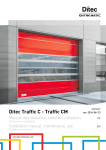
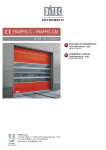
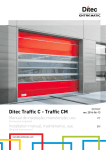
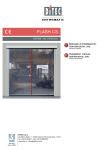
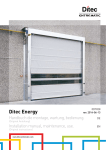
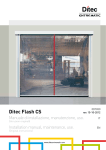
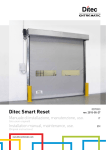
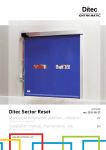
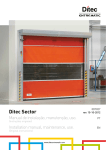
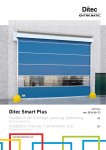
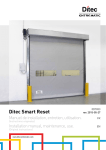
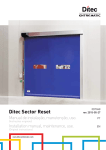
![Documentation technique [1.59 Mo]](http://vs1.manualzilla.com/store/data/006788543_1-357094a5e8900d31cb1a888bc107021d-150x150.png)
